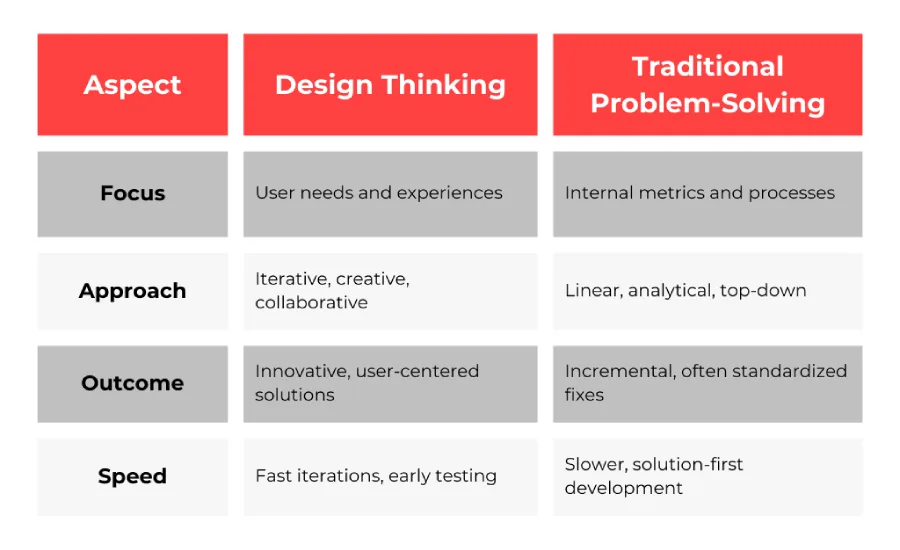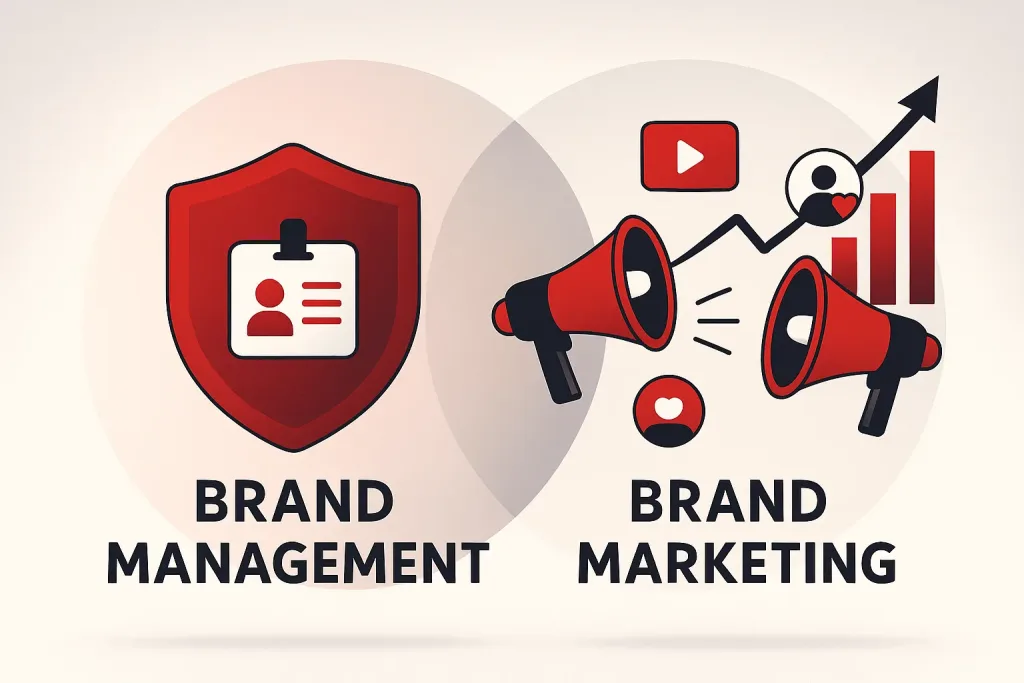In today’s hyper-competitive business landscape, standing still is not an option. Did you know that 85% of new products fail because they don’t address a real market need? That’s a staggering statistic, and it underscores a harsh truth: guessing what customers want is a recipe for disaster. Companies need a smarter, more reliable way to innovate—and that’s where design thinking comes in.
Design thinking isn’t just another trendy buzzword; it’s a human-centered, problem-solving methodology that flips traditional innovation on its head. Instead of starting with a solution and hoping it sticks, design thinking begins with people—their needs, frustrations, and aspirations. It’s a mindset and a process that empowers businesses of all sizes, from scrappy startups to global conglomerates, to create products, services, and experiences that truly resonate with their audience.
75% of organizations now incorporate design thinking into their innovation strategies, according to a recent Adobe survey. And the payoff? Companies that prioritize this approach are 2.5 times more likely to be innovation leaders in their industries . Whether you’re an entrepreneur launching your first venture, a marketing manager refining a campaign, or an investor evaluating a startup’s potential, design thinking offers a proven path to success.
What is Design Thinking?
At its core, design thinking is a structured yet adaptable framework for tackling complex problems by putting the user first. It’s often mischaracterized as a purely creative exercise reserved for designers, but that’s far from the truth. Design thinking is a universal tool that anyone—engineers, marketers, CEOs, or customer service reps—can use to uncover insights, spark innovation, and deliver solutions that work.
So, what sets it apart? Design thinking hinges on three foundational elements:
- Empathy: Stepping into your users’ shoes to understand their emotions, behaviors, and unmet needs.
- Collaboration: Bringing together diverse teams to challenge assumptions and co-create solutions.
- Iteration: Testing ideas early and often, refining them based on real feedback rather than chasing perfection upfront.
“Design thinking is a human-centered approach to innovation that draws from the designer’s toolkit to integrate the needs of people, the possibilities of technology, and the requirements for business success.”
- Tim Brown, CEO of the renowned design firm IDEO
This trifecta—people, technology, and business—makes design thinking uniquely suited to today’s dynamic markets.
A Brief History of Design Thinking
The roots of design thinking stretch back to the 1960s and 1970s, when designers and architects began formalizing their creative processes to solve practical problems. Thinkers like Herbert Simon and Robert McKim laid the groundwork by emphasizing iterative experimentation and user-focused design. However, it wasn’t until the 1990s that design thinking gained mainstream traction in the business world, largely thanks to IDEO. The firm applied it to challenges like designing Apple’s first mouse and rethinking PepsiCo’s product packaging, proving its value beyond aesthetics. Today, it’s a cornerstone of innovation across industries, from tech to healthcare to public policy.
Where Design Thinking Shines
Design thinking isn’t confined to product design—it’s versatile enough to transform entire systems. For example:
- Healthcare: The Mayo Clinic used design thinking to overhaul its patient experience. By observing patients and staff, they identified anxiety as a major barrier. Their solution—redesigned waiting areas and clearer communication—boosted patient satisfaction by 20% and cut wait times significantly.
- Government: The city of Dublin engaged citizens through design thinking workshops to improve public services. The result? Streamlined transportation and waste management systems that saved time and money while enhancing quality of life.
- Education: Stanford’s d.school applies design thinking to redesign curricula, making learning more interactive and student-centered.
This adaptability is what makes design thinking so powerful—it’s not about the industry; it’s about the people you serve.
Why Design Thinking is Essential for Business Innovation
Innovation isn’t about throwing ideas at the wall and seeing what sticks. It’s about solving real problems in ways that create value for customers and drive sustainable growth for businesses. Design thinking delivers on both fronts by keeping the user at the heart of the process. Here’s why it’s a must-have in your toolkit:
Sparks Breakthrough Creativity
By encouraging teams to explore beyond obvious solutions, design thinking uncovers opportunities that traditional methods overlook.
Strengthens Customer Relationships
When you design with users in mind, you build trust and loyalty—key drivers of repeat business and word-of-mouth growth.
Minimizes Risk and Cost
Testing ideas early through prototypes catches flaws before they balloon into expensive failures.
The numbers back this up:
- 32% higher revenue growth for design-driven companies.
- 71% of businesses report improved collaboration and culture after adopting design thinking.
- 50% faster time-to-market for new products, thanks to rapid iteration.
But its impact goes beyond products. Design thinking can revolutionize internal processes—like streamlining employee onboarding to boost retention—or even reshape customer service workflows to reduce complaints. It’s a holistic approach that aligns your business with what people actually want.

Real-World Example for design thinking in business: GE Healthcare
Consider GE Healthcare’s challenge: children were terrified of MRI scans, often requiring sedation. Using design thinking, they observed kids and families, uncovering that the clinical environment felt cold and intimidating. Their solution? Transform the MRI experience into an “adventure” with themed rooms (like a pirate ship) and staff trained to narrate the process as a story. The result: fewer sedations, happier patients, and a differentiated service that set GE apart in a competitive market.
The Design Thinking Process: A Step-by-Step Breakdown
Design thinking follows five iterative stages, but it’s not a straight line—you can loop back as needed. Here’s how it works, with practical examples:
1. Empathize
- What it is: Immerse yourself in your users’ world to uncover their real needs.
- How to do it: Conduct interviews, observe behaviors, or map customer journeys.
- Example: A coffee shop chain noticed long lines at peak hours. Talking to customers revealed that many were commuters desperate for a quick coffee fix.
2. Define
- What it is: Synthesize your findings into a clear, user-focused problem statement.
- How to do it: Frame it as “How might we…” (e.g., “How might we speed up ordering for busy commuters?”).
- Example: The coffee shop defined their issue: “Commuters need a fast, hassle-free way to get coffee.”
3. Ideate
- What it is: Brainstorm a wide range of solutions without judgment.
- How to do it: Try “crazy eights” (eight ideas in eight minutes) or group sketching.
- Example: Ideas ranged from a mobile app for pre-orders to a self-serve coffee station.
4. Prototype
- What it is: Build tangible, low-cost versions of your ideas to test.
- How to do it: Use paper mockups, digital wireframes, or even role-playing.
- Example: Nordstrom prototyped a sunglass app in-store, letting customers virtually try on shades and share feedback instantly.
5. Test
- What it is: Put your prototypes in users’ hands and refine based on their input.
- How to do it: Run usability tests, watch interactions, and ask “What worked? What didn’t?”
- Example: Airbnb tested its platform and learned that listings with high-quality photos got more bookings. They offered free photography to hosts, fueling exponential growth.
Integration design thinking with Other Methods
If you’re already using agile or lean startup approaches, design thinking fits like a glove. Agile’s iterative sprints align with prototyping and testing, while lean startup’s focus on validated learning complements empathy and iteration. Together, they create a powerhouse process balancing user needs, technical feasibility, and business viability.
Design Thinking vs. Traditional Problem-Solving
Traditional problem-solving often follows a rigid, linear path: define the issue, analyze data, and deploy a solution. Design thinking takes a messier, more dynamic route. Here’s the comparison:
 Why does this matter? In fast-moving markets, linear thinking can lag behind customer expectations. Design thinking’s adaptability lets you pivot quickly and deliver what people actually need. As Toptal notes, “Its iterative nature excels at tackling complex, ill-defined problems where traditional methods falter.”
Why does this matter? In fast-moving markets, linear thinking can lag behind customer expectations. Design thinking’s adaptability lets you pivot quickly and deliver what people actually need. As Toptal notes, “Its iterative nature excels at tackling complex, ill-defined problems where traditional methods falter.”
Challenges in Adopting Design Thinking And Solutions
Design thinking isn’t without hurdles, especially for businesses new to the approach. Here’s how to navigate them:
Challenge 1: Resistance to Change
- Why: Teams may view it as “too soft” or disruptive to established workflows.
- Solution: Start with a small pilot—like redesigning a checkout process—and showcase the wins.
- Example: PepsiCo piloted design thinking for Tropicana’s packaging, leading to a successful relaunch and company-wide buy-in.
Challenge 2: Resource Constraints
- Why: SMEs or startups may lack time, budget, or staff.
- Solution: Focus on high-impact projects and use cheap prototypes (e.g., sketches or cardboard models).
- Example: A boutique retailer tested a new store layout in one location, scaling it after seeing a 10% sales bump.
Challenge 3: Measuring Success
- Why: Early benefits (e.g., team morale) can feel intangible.
- Solution: Track hard metrics (sales, retention) and soft gains (customer praise).
- Example: A tech firm revamped onboarding with design thinking, cutting early churn by 15%.
Hidden Perk
Beyond solving problems, design thinking rewires your team’s mindset. Embracing failure as a learning tool builds resilience and fosters a culture of experimentation—priceless in today’s unpredictable world.
Getting Started with Design Thinking: Actionable Steps
Ready to roll? Here’s how to kick off design thinking in your business:
- Build a Diverse Team: Mix perspectives—sales, product, support—to spark richer ideas.
- Set Up a Creative Space: Dedicate a room (or virtual board) for brainstorming and prototyping.
- Start Small: Tackle a simple challenge, like shortening customer wait times, to build confidence.
- Fail Fast, Learn Faster: Encourage risk-taking and treat missteps as progress.
- Gather Feedback Continuously: Test with users at every stage to stay on track.
Pro Tip: Short on expertise? Partner with INNOBASE Our Branding & Marketing Strategy services guide you through the process, ensuring you nail empathy, ideation, and execution without the trial-and-error slog.
Take the Leap with INNOBASE
At INNOBASE, we specialize in translating the abstract principles of design thinking into tangible, impactful outcomes. We facilitate the application of this methodology to address real-world business imperatives, moving beyond theoretical frameworks to practical implementation.
Our services are designed to help you at every stage, from Innovation Management & Growth Strategy and Business Design & Corporate Venture Building, to crafting winning Product & Service Innovations and Branding & Marketing Strategies. We also guide Business Transformation & Digital Shift, and offer Custom-Built Consulting Services tailored to your unique needs.
Whether the focus is on revitalizing brand identity to resonate with contemporary audiences, developing groundbreaking products that meet unmet market needs, or streamlining internal processes to enhance operational efficiency, we guide businesses in harnessing design thinking to drive meaningful, measurable results. We focus on transforming insights into actionable strategies, ensuring that innovation is not just a concept, but a lived reality.


